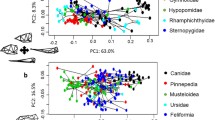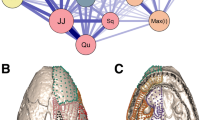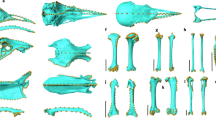Abstract
Changes in patterns and magnitudes of integration may influence the ability of a species to respond to selection. Consequently, modularity has often been linked to the concept of evolvability, but their relationship has rarely been tested empirically. One possible explanation is the lack of analytical tools to compare patterns and magnitudes of integration among diverse groups that explicitly relate these aspects to the quantitative genetics framework. We apply such framework here using the multivariate response to selection equation to simulate the evolutionary behavior of several mammalian orders in terms of their flexibility, evolvability and constraints in the skull. We interpreted these simulation results in light of the integration patterns and magnitudes of the same mammalian groups, described in a companion paper. We found that larger magnitudes of integration were associated with a blur of the modules in the skull and to larger portions of the total variation explained by size variation, which in turn can exert a strong evolutionary constraint, thus decreasing the evolutionary flexibility. Conversely, lower overall magnitudes of integration were associated with distinct modules in the skull, to smaller fraction of the total variation associated with size and, consequently, to weaker constraints and more evolutionary flexibility. Flexibility and constraints are, therefore, two sides of the same coin and we found them to be quite variable among mammals. Neither the overall magnitude of morphological integration, the modularity itself, nor its consequences in terms of constraints and flexibility, were associated with absolute size of the organisms, but were strongly associated with the proportion of the total variation in skull morphology captured by size. Therefore, the history of the mammalian skull is marked by a trade-off between modularity and evolvability. Our data provide evidence that, despite the stasis in integration patterns, the plasticity in the magnitude of integration in the skull had important consequences in terms of evolutionary flexibility of the mammalian lineages.





Similar content being viewed by others
References
Akesson, M., Bensch, S., & Hasselquist, D. (2007). Genetic and phenotypic associations in morphological traits: A long term study of great reed warblers Acrocephalus arundinaceus. Journal of Avian Biology, 38, 58–72. doi:10.1111/j.2006.0908-8857.03669.x.
Ancel, L. W., & Fontana, W. (2000). Plasticity, evolvability and modularity. The Journal of Experimental Zoology, 288, 242–283. doi:10.1002/1097-010X(20001015)288:3<242::AID-JEZ5>3.0.CO;2-O.
Arnold, S. J. (1981). Behavioral variation in natural populations. I. Phenotypic, genetic and environmental correlations between chemoreceptive responses to prey in the garter snake, Thamnophis elegans. Evolution; International Journal of Organic Evolution, 35, 489–509. doi:10.2307/2408197.
Arnold, S. J. (1992). Constraints on phenotypic evolution. American Naturalist, 140, S85–S107. doi:10.1086/285398.
Arnold, S. J., & Phillips, P. C. (1999). Hierarchical comparison of genetic variance-covariance matrices. II. Coastal-island divergence in the garter snake, Thamnophis elegans. Evolution; International Journal of Organic Evolution, 53, 1516–1527. doi:10.2307/2640897.
Berg, R. L. (1960). The ecological significance of correlation pleiades. Evolution; International Journal of Organic Evolution, 14(2), 171–180. doi:10.2307/2405824.
Chernoff, B., & Magwene, P. M. (1999). Morphological integration: 40 years later. In E. C. Olson & R. L. Miller (Eds.), Morphological integration. Chicago: University of Chicago Press.
Cheverud, J. M. (1982). Phenotypic genetic and environmental morphological integration in the cranium. Evolution; International Journal of Organic Evolution, 36(3), 499–516. doi:10.2307/2408096.
Cheverud, J. M. (1984). Quantitative genetics and developmental constraints on evolution by selection. Journal of Theoretical Biology, 110, 155–172. doi:10.1016/S0022-5193(84)80050-8.
Cheverud, J. M. (1988). A comparison of genetic and phenotypic correlations. Evolution, 42, 958–968.
Cheverud, J. M. (1995). Morphological integration in the saddle-back tamarin (Saguinus fuscicollis) cranium. American Naturalist, 145, 63–89.
Cheverud, J. M. (1996). Developmental integration and the evolution of pleiotropy. American Zoologist, 36, 44–50.
Cheverud, J. M., & Marroig, G. (2007). Comparing covariance matrices: Random skewers method compared to the common principal components model. Genetics and Molecular Biology, 30(2), 461–469. doi:10.1590/S1415-47572007000300027.
Cheverud, J. M., Wagner, G., & Dow, M. M. (1989). Methods for the comparative analysis of variation patterns. Systematic Zoology, 38(3), 201–213. doi:10.2307/2992282.
Estes, S., Arnold, S. J. (2007). Resolving the paradox of stasis: Models with stabilizing selection explain evolutionary divergence on all timescales. American Naturalist, 169, 227–244.
Hansen, T. F. (2003). Is modularity necessary for evolvability? Remarks on the relationship between pleiotropy and evolvability. Bio Systems, 69(2–3), 83–94. doi:10.1016/S0303-2647(02)00132-6.
Hansen, T. F., & Houle, D. (2008). Measuring and comparing evolvability and constraint in multivariate characters. Journal of Evolutionary Biology, 21(5), 1201–1219. doi:10.1111/j.1420-9101.2008.01573.x.
House, C. M., & Simmons, L. W. (2005). The evolution of male genitalia: patterns of genetic variation and covariation in the genital sclerites of the dung beetle Onthophagus taurus. Journal of Evolutionary Biology, 18, 1281–1292. doi:10.1111/j.1420-9101.2005.00926.x.
Jones, A. G., Arnold, S. J., Borger, R. (2003). Stability of the G-matrix in a population experiencing pleiotropic mutation, stabilizing selection, and genetic drift. Evolution, 57, 1747–1760.
Lande, R. (1979). Quantitative genetic analysis of multivariate evolution applied to brain: Body size allometry. Evolution; International Journal of Organic Evolution, 33, 402–416. doi:10.2307/2407630.
Lovsfold, D. (1986). Quantitative genetics of morphological differentiation in Peromyscus. I. Tests of the homogeneity of genetic covariance structure among species and subspecies. Evolution; International Journal of Organic Evolution, 40, 559–573. doi:10.2307/2408577.
Marroig, G., & Cheverud, J. M. (2001). A comparison of phenotypic variation and covariation patterns and the role of phylogeny ecology and ontogeny during cranial evolution of New World monkeys. Evolution; International Journal of Organic Evolution, 55(12), 2576–2600.
Oliveira, F. B., Porto, A., & Marroig, G. (2009). Covariance structure in the skull of Old World Monkeys: A case of pattern stasis and magnitude evolution. Journal of Human Evolution, in press.
Olson, E. C., & Miller, R. L. (1958). Morphological integration. Chicago: University of Chicago Press.
Porto, A., Oliveira, F. B., Shirai, L. T., De Conto, V., & Marroig, G. (2009). The evolution of modularity in the mammalian skull I: Morphological integration patterns and magnitudes. Evolutionary Biology. doi:10.1007/s11692-008-9038-3.
Reale, D., & Festa-Bianchet, M. (2000). Quantitative genetics of life-history traits in a long-lived wild mammal. Heredity, 85, 593–603. doi:10.1046/j.1365-2540.2000.00795.x.
Reusch, T., & Blanckenhorn, W. U. (1998). Quantitative genetics of the dung fly Sepsis cynipsea: Cheverud’s conjecture revisited. Heredity, 81, 111–119. doi:10.1046/j.1365-2540.1998.00368.x.
Roff, D. A. (1995). The estimation of genetic correlations from phenotypic correlations—A test of Cheverud’s conjecture. Heredity, 74, 481–490. doi:10.1038/hdy.1995.68.
Schlosser, G., & Wagner, G. P. (2004). Modularity in development and evolution. Chicago: University of Chicago Press.
Schluter, D. (1996). Adaptive radiation along genetic lines of least resistance. Evolution, 50, 1766–1774.
Wagner, G. P., & Altenberg, L. (1996). Complex adaptations and the evolution of evolvability. Evolution; International Journal of Organic Evolution, 50(3), 967–976. doi:10.2307/2410639.
Wagner, G. P., Pavlicev, M., & Cheverud, J. M. (2008). The road to modularity. Nature Reviews. Genetics, 8, 921–931. doi:10.1038/nrg2267.
Waitt, D. E., & Levin, D. A. (1998). Genetic and phenotypic correlations in plants: A botanical test of Cheverud’s conjecture. Heredity, 80, 310–319. doi:10.1046/j.1365-2540.1998.00298.x.
Acknowledgements
We thank Campbell Rolian and Katherine Willmore for the opportunity to present this data in the 2008 AAPA meeting. Many thanks also to an anonymous reviewer for comments that helped us to improve an earlier version of the text, and to Thomas Hansen, for his suggestion of the term flexibility for the correlation between selection vector and the evolutionary responses. We are also grateful to those people and institutions that provided generous help and access to mammal collections: E. Westwig, R. Voss and R. MacPhee (AMNH); L. Tomsett, P. Jenkins and D. Hills (BMNH); B. Paterson, W. Stanley, and L. Heaney (FMNH); J. Chupasko and M. Omura (MCZ); M. Godinot, F. Renoult, C. Lefrève and J. Cuisin (MNHN); L. Salles, J. Oliveira, F. Barbosa, and S. Franco (MNRJ); S. Costa and J. de Queiroz (MPEG); Staff at the Museo de la Universidad Nacional Mayor de San Marcos; M. de Vivo and J. Gualba (MZUSP); H. van Grouw and B. Bekkum-Ansari (Naturalis); R. Thorington, R. Chapman and L. Gordon (NMNH); M. Harman (Powell-Cotton Museum); Georges Lenglet (RBINS); E. Gilissen and W. Wendelen (RMCA); R. Asher, I. Thomas and D. Willborn (ZMB); F. Smith and S. Tardif (University of Tennessee, and the Oak Ridge Associated Universities Marmoset Research Center); C. Zollikofer, M. Ponce de Léon and T. Jashashvili (Zürich Universität); R. Smith (Museu de Anatomia da UNIFESP); E. Liberti (Museu de Anatomia “Professor Alfonso Bovero”). This research was supported by grants and fellowships from Fundação de Amparo à Pesquisa do Estado de São Paulo (FAPESP), Coordenação de Aperfeiçoamento de Pessoal do Ensino Superior (CAPES), Conselho Nacional de Pesquisas (CNPq), Fundação de Amparo à Pesquisa do Estado do Rio de Janeiro (FAPERJ), and an American Museum of Natural History Collections Study Grant.
Author information
Authors and Affiliations
Corresponding author
Rights and permissions
About this article
Cite this article
Marroig, G., Shirai, L.T., Porto, A. et al. The Evolution of Modularity in the Mammalian Skull II: Evolutionary Consequences. Evol Biol 36, 136–148 (2009). https://doi.org/10.1007/s11692-009-9051-1
Received:
Accepted:
Published:
Issue Date:
DOI: https://doi.org/10.1007/s11692-009-9051-1




